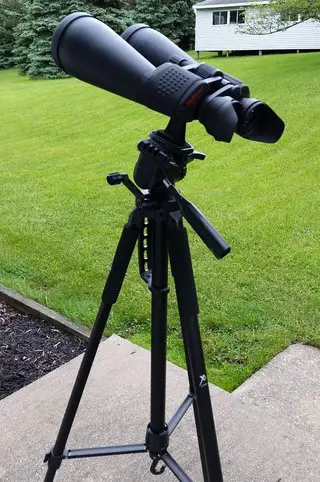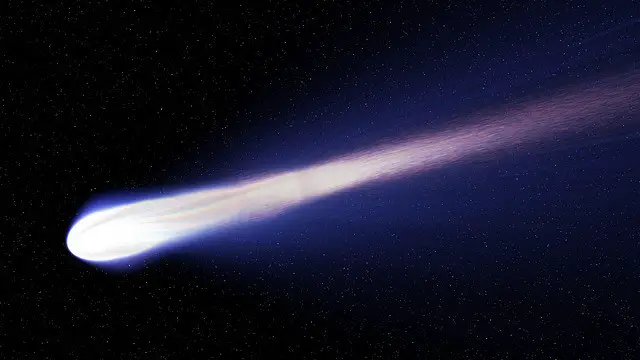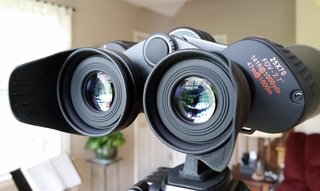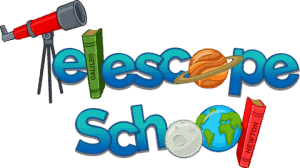Astronomy is a gratifying hobby, especially for anyone fascinated by the vastness of the universe and the things that are in it. For most of us, our first exposure on astronomy was through published pictures from NASA, ESA, and the like from other space agencies.
So we then set out armed with the thinking we need a telescope to see these things with our very own eyes. However, binoculars offer a very inexpensive and viable way to see many of the closest neighbors in space.
So What are the Top 10 Things to See With Binoculars?
- Moon
- Planets
- International Space Station (ISS)
- Double Cluster
- The Pleiades
- Lagoon Nebula
- Orion Nebula
- Andromeda galaxy
- Comets
- M81 and M82
What Advantages Do Binoculars Have Over Telescopes?
The main advantage of starting out with binoculars is the versatility and ease of use. Most people who buy a telescope let it sit and collect dust and sadly to say, sell it when they move or sell it when they may be strapped for cash between jobs.
Telescopes take an effort to set up and use. From eyepieces, collimation, and the upside-down inverted image telescopes offer. This makes a telescope more challenging to learn than just grabbing and staring at the sky with binoculars on a clear night.
Yes, binoculars can come in high powers that require a mount, or tripod. Also, because you are viewing straight from the end of binoculars, you do not have use of diagonals like with a telescope. Positioning yourself could be difficult.
This is when guys build a mirror mount that resembles a microscope more than a telescope. Allowing the observer to sit down while using. Binoculars are focused on a mirror that is reflecting the sky back to the binoculars. The mirror mount is built typically to swivel and tilt to allow an easy view of most anything that is up.
Here are the Top 10 Things in Greater Detail that You Can See in the Night Sky with Binoculars.
1. The Moon
It is easy to overlook the moon as a good thing to look at since most anyone can already see it with their naked eye. However, the moon has a ton of different features that can be seen using binoculars. You would be amazed at all the details that you will find regarding its geography.
A good thing about observing the moon is that it is effortless to find in the night sky and does not require complex star maps or other tools. The phases of the moon are very lovely to observe and offer ever-changing details.
The terminator line is the line separating the illuminated side of the moon and the dark side, is the best place to look. It will show the features in higher contrast and detail from the shadowing effect.
2. The Planets
It may be hard to believe, but you will still be able to see the close planets with your binoculars. Mercury and Venus can be seen best when viewed during twilight, or dusk instead of at night because of their close proximity to the sun. Also, because of this, you will notice that these planets also have phases like the moon.
Mars and its reddish hue through binoculars is harder to spot, however, all planets because they move rapidly through the night sky can be hard to spot.
For Jupiter, you can see four of its moons. Viewing Jupiter and its moons is very special because these are some of the first objects ever observed by Galileo using his famous telescope. View them over several nights to see the satellites change position as they orbit around Jupiter.
For Saturn, unfortunately, it will be challenging to see the rings. But the beautiful golden colors can start to show and make it a good look.
Lastly, Uranus and Neptune can still be seen using binoculars even with their great distance from Earth. It will just take a lot of skill and practice with the use of a finder chart.
As a takeaway, you are not going to see NASA quality images, but you can see them none the less.
3. The International Space Station
You can witness the International Space Station with the naked eye, but it is more fun to see it using binoculars and make out some of its details. Finding it in the sky is easy because there are lots of resources like websites and apps that readily point to its location. It is best to find them before sunrise or after sunset because the sun’s brightness will make it impossible to see.
4. Double Cluster
The double cluster is one of the few things that is better to look at using binoculars, rather than a telescope because of a wider field of view. It is composed of two-star clusters near each other when viewed in the night sky. The Clusters are part of the Perseus constellation, representing the jeweled handle of the hero’s sword.
5. The Pleiades
The Pleiades or the Seven Sisters are one of the most popular objects in the night sky for astronomers. The Pleiades actually consist of more than 7 stars, thousands, in fact, but you will be able to see the 7 of these using your binoculars.
The Pleiades also occupies a relatively large part of the night sky like the double cluster, which makes it a good view using binoculars.
6. Lagoon Nebula
The Lagoon Nebula is a large gas cloud that is also a part of our Milky Way. It is visible with the naked eye, although just as a small smudge. Using binoculars, you will be able to make out some of its details. It can be found near the Teapot asterism, which is a part of the Sagittarius constellation.
7. Orion Nebula
The Orion Nebula being one of the few nebulae that can be seen with the naked eye, provided that there is minimal to zero light pollution. This is because it is the closest stellar nursery to Earth. It has a distinct asymmetrical shape which makes it wonderful to look at.
It is located in the sword of the Orion Constellation
8. Andromeda Galaxy (M31)
The Andromeda is the closest galaxy to the Milky Way, with a distance of 2.5 million light-years. It can be seen with the naked eye because of its brightness. However, It is much more satisfying to view it using binoculars. You will be able to make out the familiar spiral galaxy shape and with the typical big bright core that is surrounded by lots of different star systems.
9. Comets
Comets are also better to look at using binoculars than using a telescope. Binoculars will give a wider field of view, allowing you to see the comet along with its long trailing tail in one whole picture.
They do not appear regularly as other objects in the night sky, so staying attuned to astronomy news to be in the know for when a comet will be visible.
The arguably most famous comet, Halley’s Comet, for example, appears about every 75 years. It will be visible again in 2061.
10. M81 and M82
The M81 and M82 galaxies are 2 spiral galaxies that can be found in the constellation Ursa Major. These 2 galaxies have violently crashed into each other, as evident from the dusty lanes that can be seen between them.
The M81 galaxy contains a very active nucleus with a super-massive black hole inside it. This super-massive black hole is incredibly massive, with a mass of around 70 million times the mass of our sun.
Recommended Best Binoculars to See Space Stuff
Available binoculars in the market can be grouped based on their size. The best small handheld binoculars are:
These guys are the best Binoculars for multiple uses like astronomy and hunting, or hiking.
Next we have the medium-sized binoculars that can also be handheld if braced. The best of this type are:
Large binoculars cannot be handheld and must be used with a tripod or mount. The best of this type are:

If you are really determined in using binoculars for your astronomy hobby, there are also binoculars available that are much larger than those mentioned above. The best of this type are:
- Kowa Highlander 32 x 82
- Barska 40 x 100, Waterproof
- 15X70 Celestron is 15X the power of the naked eye. The diameter, or aperture is the second number in the numbers. Just like in telescopes, the bigger, the better for space because it allows more light into and focuses toward the eyepiece.
As with telescopes I do not recommend a telescope under 70mm in aperture diameter. With binoculars, you are seeing with both eyes, and as in our example above a 70mm aperture with two eyes would be brighter than a 70mm aperture telescope (one eye).
Price Range, and Places To Buy
Prices for good space seeing binoculars start from around $65 to $300 or more depending on the size and specifications. There are lots of online stores nowadays that sell binoculars. Which means you should stick with reputable brands in short.
Amazon offers excellent new units from many manufacturers. Make sure you order one with Prime shipping times, so you can start star gazing in a couple days. Check out binoculars on Amazon, or check them out at BH Photo, or Highpoint Scientific
Are There Extra Accessories Needed, Like Eyepieces?
Binoculars are pretty much ready to use without needing any accessories. Most of the accessories that you will find for binoculars are just tools to keep them safe and to steady them while using. See binocular accessories on amazon here. OR What you Should Know About the Moon to Improve Your Viewing



